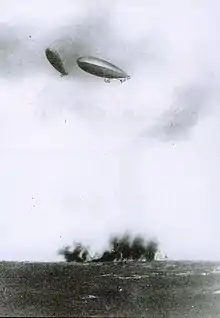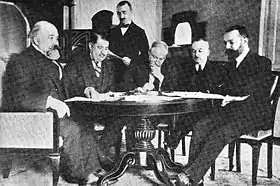1912 in Italy
See also: 1911 in Italy, other events of 1912, 1913 in Italy.
| Years in Italy: | 1909 1910 1911 1912 1913 1914 1915 |
| Centuries: | 19th century · 20th century · 21st century |
| Decades: | 1880s 1890s 1900s 1910s 1920s 1930s 1940s |
| Years: | 1909 1910 1911 1912 1913 1914 1915 |
Events from the year 1912 in Italy.
Kingdom of Italy
- Monarch – Victor Emmanuel III (1900–1946)
- Prime Minister – Giovanni Giolitti (1911–1914)
- Population – 35,246,000
Events

Italian dirigibles bomb Turkish positions in Libya. The Italo-Turkish War of 1911–1912 was the first in history in which air attacks (carried out here by dirigible airships) determined the outcome.

Turkish and Italian delegations in Lausanne (1912). From left to right (seating): Pietro Bertolini, Mehmet Nabi Bey, Guido Fusinato, Rumbeyoğlu Fahreddin Bey, and Giuseppe Volpi.
The Italo-Turkish War between the Kingdom of Italy and the Ottoman Empire over Italian claims in Libya is ongoing. While Italian conscripts faced death in the Libyan desert, a new electoral law grants almost universal male suffrage; the electorate, below 3 million in 1909, rises to nearly 8.5 million.[1]
- January 7 – The Battle of Kunfuda Bay, the largest naval battle of the Italo-Turkish War in the Red Sea. the Italian cruiser Piemonte, with the Soldato-class destroyers Artigliere and Garibaldino, sank seven Turkish gunboats. Successively the Italians blocked and damaged the main ports of Yemen.
- February 24 – Battle of Beirut: Italy launches a surprise attack on the Ottoman port of Beirut; the cruiser Giuseppe Garibaldi and the gunboat Volturno bombard the harbour, killing 97 sailors and civilians. As a result of the battle all Ottoman naval forces in the region were annihilated, thus ensuring the approaches to the Suez Canal were open to the Italians. The Ottoman naval presence at Beirut was completely annihilated and casualties on the Ottoman side were heavy. The Italian navy gained complete naval dominance of the southern Mediterranean for the rest of the war.
- March 6 – Italian forces are the first to use airships in war, as two dirigibles drop bombs on Turkish troops encamped at Janzur in north-western Libya, from an altitude of 6,000 feet.[2] Although Italy could extend its control to almost all of the 2,000 km of the Libyan coast between April and early August 1912, its ground forces could not venture beyond the protection of the navy's guns and were thus limited to a thin coastal strip.
- May – Italy occupies 13 Turkish-held Dodecanese islands, including Rhodes, in the Aegean Sea.
- July 10 – The Italian Reformist Socialist Party is founded by leading reformists Leonida Bissolati and Ivanoe Bonomi who had been expelled from the Italian Socialist Party because of their desire of entering in the majority supporting Prime Minister Giovanni Giolitti. Bissolati's refusal to oppose the war with Turkey for the conquest of Libya triggered his resignation as socialist Member of Parliament in February 1912.
- October 18 – With the Treaty of Lausanne in Ouchy near Lausanne the Italo-Turkish War ends. The war costs Italy 1.3 billion lire, nearly a billion more than Prime Minister Giovanni Giolitti estimated before the war, ruining ten years of fiscal prudence.[3] Italy obtains control over the colonies of Cyrenaica and Tripolitania, as well as the Dodecanese islands. After the withdrawal of the Ottoman army the Italians could easily extend their occupation of Libya, seizing East Tripolitania, Ghadames, the Djebel and Fezzan with Murzuk during 1913.
- November 20 – The Ministry of the Colonies is established to govern the country's colonial possessions and the direction of their economies.
- November 23 – Revolutionary syndicalist organizations leave the Confederazione Generale del Lavoro (CGdL) trade union and form the Unione Sindacale Italiana (USI).[4]
- December 1 – Benito Mussolini, one of the leaders of the extreme left majority of the Italian Socialist Party, assumes the direction of party newspaper Avanti!.[4]
Sports
- March 31 – The French rider Henri Pélissier wins the 6th Milan–San Remo bicycle race.
- May 5 – Pro Vercelli wins the 1911–12 Italian Football Championship.
- May 25–26 – The British driver Cyril Snipe and his co-driver Pedrini win the 1912 Targa Florio endurance automobile race on Sicily.
- May 19 – June 4 – The Atala-Dunlop team that finished with Carlo Galetti, Eberardo Pavesi, and Giovanni Micheletto, wins the 4th Giro d'Italia stage bicycle race.
- October 27 – The Italian rider Carlo Oriani wins the 8th Giro di Lombardia bicycle race.
Births
- March 4 – Afro Basaldella, Italian painter (d. 1976)
- September 29 – Michelangelo Antonioni, Italian film director (d. 2007)
- October 17 – Pope John Paul I, Italian churchman (d. 1978)
- December 11 – Carlo Ponti, Italian film producer (d. 2007)
- December 24 – Natalino Otto, Italian singer (d. 1969)
Deaths
- March 4 – Augusto Aubry, Italian admiral and politician (b. 1849)
- March 22 – Ruggero Oddi, Italian physiologist and anatomist (b. 1864)
- April 6 – Giovanni Pascoli, Italian poet (b. 1855)
References
- Clark, Modern Italy: 1871 to the present, p. 188
- Dirigibles in Tripoli War, The New York Times, March 8, 1912
- Choate, Emigrant nation, p. 175
- (in Italian) XXIII Legislatura del Regno d'Italia dal 24 marzo 1909 al 29 settembre 1913, Camera dei deputati, Portale storico (retrieved 28 May 2016)
- Choate, Mark I. (2008). Emigrant nation: the making of Italy abroad, Boston: Harvard University Press, ISBN 0-674-02784-1
- Clark, Martin (2008). Modern Italy: 1871 to the present, Harlow: Pearson Education, ISBN 1-4058-2352-6
This article is issued from Wikipedia. The text is licensed under Creative Commons - Attribution - Sharealike. Additional terms may apply for the media files.